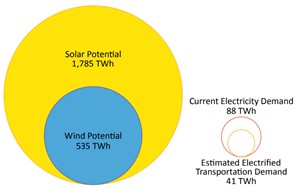New Report: WA Wind and Solar Could Supply All of State’s Energy
Media Contacts
Seattle, WA – The winds of change are coming to Washington state, and we’re prepared to take full advantage of them. Washington has the clean energy resources to meet all of our energy needs. In fact, according to the new Environment Washington Research and Policy Center report, Road to a Fossil Free Washington: How Renewable Energy and Electric Vehicles can Repower Washington State, just 5.5 percent of Washington’s wind and solar energy potential could power all the electricity our state currently needs, plus the estimated demand once all our vehicles are electric, rather than gas-powered.
“We have the power,” said Bruce Speight, Environment Washington Executive Director. “We can repower our entire energy economy in Washington with clean, renewable energy and cities across Washington can be a leader in that transition.
Just 5.5 Percent of Washington’s Wind and Solar Potential Could Power Current Electricity Demand Plus Estimated Demand from a Fully Electrified Vehicle Fleet

More than 25,000 electric vehicles (EVs) are already on the road in Washington. That’s the third most of any state in the country. And Washington is well-prepared for a jump in EV sales, with nearly 700 public charging stations across the state.
In addition to tangible environmental and public health benefits, clean energy has already brought big economic benefits to Washington, including $375 million in solar investments, 157 solar companies, $6 billion in wind investment, more than 3,000 wind jobs, and 10 manufacturing facilities in the state. Eastern Washington in particular would benefit from investment in wind and solar farms, since it is home to the bulk of the state’s renewable energy potential.
“The real challenge is putting the pedal to the metal on electric vehicle adoption and renewable energy in Washington,” continued Speight. “Not only will it reduce air, water, and climate pollution, it will create thousands of jobs and power our economy with homegrown energy. Our communities and state have so much to gain by taking aggressive steps now.”
The driving that occurs within our state’s borders accounts for 39 billion gallons of imported fuel burned each year, and 43 percent of the state’s annual global warming emissions, or 45 million tons. By switching to electric vehicles (EVs) that can run on renewable energy, Washington can clean our environment, meet our climate goals, and build a vibrant clean energy economy that uses energy produced here at home. For example, small buildings in cities like Oak Harbor, Mukilteo, and Wenatchee could host enough rooftop solar to power 100 percent of an electrified transportation system. (A map with city-by-city data can be found here.)
“Environment Washington has laid out a roadmap for Spokane to lead in renewable energy development in Washington state,” said Spokane City Council President Ben Stuckart. “Washington state can be fossil free. It doesn’t take a miracle. It simply takes commitment. It’s time to repower Washington one community at a time.”
“One of the best things about electric vehicles is that you can power them with clean energy,” said Gideon Weissman of Frontier Group, report co-author. “We found that by tapping into just a fraction of Washington’s wind and solar resources, we could power both our current electricity needs, and get all the electricity we would need for electric vehicles.”
To accelerate the change to renewable energy and electric vehicles, the report recommends a number of steps state policymakers should take, including:
• Set ambitious and enforceable renewable energy goals,
• Adopt the zero-emission vehicle program, currently in place in 10 states, which requires automakers to sell an increasing number of zero-emission vehicles, including EVs,
• Expanding EV charging infrastructure across the state, and
• Removing any barriers to EV ownership, including Washington’s $100 annual electric vehicle registration fee.
At the same time, cities have a variety of policy solutions at their disposal to rapidly advance adoption of electric vehicles and clean energy, including:
• Cutting red tape. Cities can reduce barriers standing in the way of clean energy adoption, including by streamlining or putting online the solar permitting process.
• Creating clean energy building codes. Cities can require that new construction includes clean energy.
• Using clean energy for public buildings and fleets. Cities can install solar panels on municipal rooftops and municipal property, and use EVs for public fleets.
• Setting clean energy goals. Dozens of cities across the country have made commitments to obtain the bulk or the entirety of their energy from clean, renewable sources.
“Cities across Washington can help lead Washington toward a 100 percent electrified transportation and renewable energy economy,” concluded Speight. “We’re eager to work with state and local leaders to take the next big steps and put us on the ‘Road to a Fossil Free Washington’.”
###
Environment Washington Research & Policy Center is a 501(c)(3) organization. We are dedicated to protecting our air, water and open spaces. We investigate problems, craft solutions, educate the public and decision-makers, and help the public make their voices heard in local, state and national debates over the quality of our environment and our lives. For more information, visit www.environmentwashingtoncenter.org.
